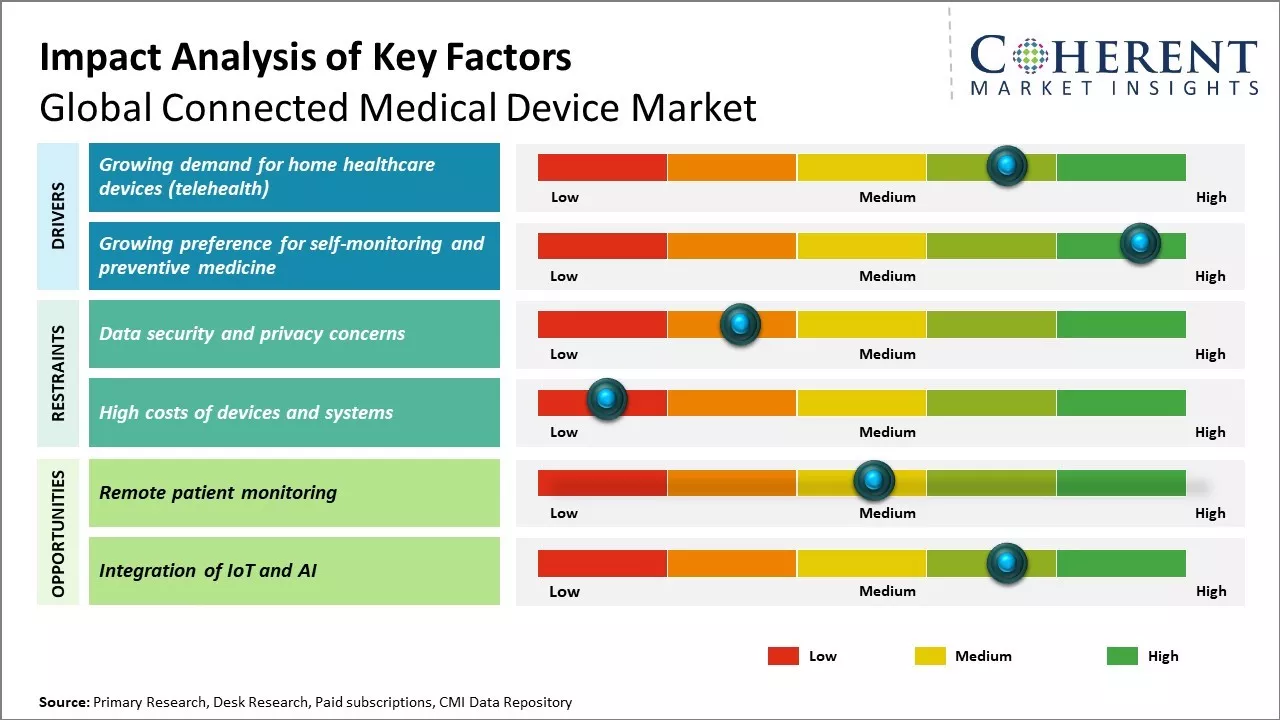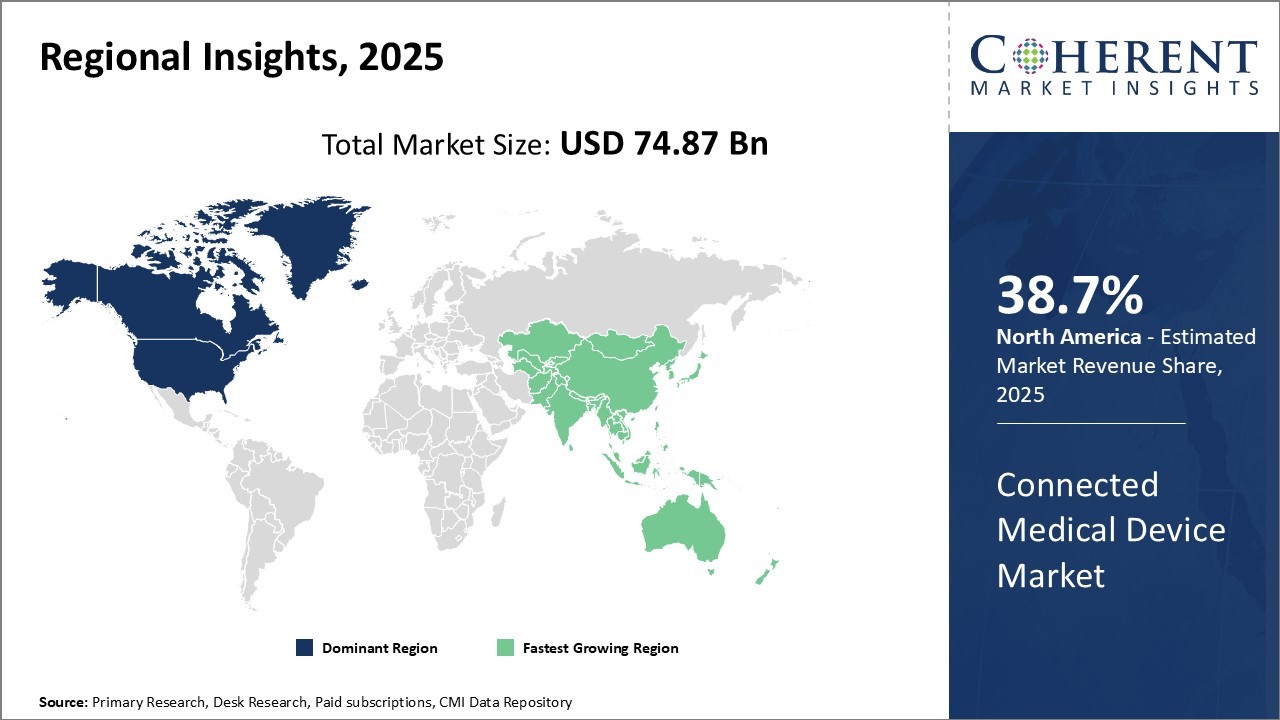Global connected medical device market is estimated to be valued at USD 74.87 Bn in 2025 and is expected to reach USD 199.28 Bn by 2032, exhibiting a compound annual growth rate (CAGR) of 15.0% from 2025 to 2032.

To learn more about this report, Download Free Sample
The connected medical device market is growing quickly as more healthcare providers adopt remote patient monitoring, wearables, and technologies like IoT and AI. North America currently dominates the market, while countries like India and China in the Asia-Pacific region are catching up due to ongoing healthcare digitization and rising patient numbers. Devices such as smart glucose monitors, wearable ECGs, blood pressure trackers, implantable sensors, and connected imaging systems actively support real-time data sharing, enable early interventions, and streamline workflows across hospitals and home care settings.
|
Current Events |
Description and its impact |
|
Regulatory Policy Shifts |
|
|
Cybersecurity Mandates |
|
|
Reimbursement and Investment Shifts |
|
Uncover macros and micros vetted on 75+ parameters: Get instant access to report
Wearable Devices segment is estimated to contribute the highest market share of 50.5% in 2025. Wearable medical devices allow patients to proactively track key health vitals such as heart rate, blood pressure, blood glucose levels and activity levels from the convenience of their own home without needing to regularly visit a doctor or medical facility. This empowers patients to have greater control and visibility over their health. Activity trackers and smart watches are the most popular type of wearable devices as these can monitor daily activities and lifestyle metrics including steps walked, calories burned, quality of sleep and more. This data helps individuals better understand patterns in their routine that may influence their wellness. Some smart watches also have ECG and fall detection capabilities to monitor cardiac activity and detect emergencies. Patches are thin, flexible devices that can be attached to the skin to continuously monitor vitals without causing much discomfort to users. For instance, SynPhNe is the world’s first wearable, connected technology that trains both the brain and body within a single system. It helps individuals with cognitive and physical functional disorders or disabilities improve their independence and regain their quality of life. This is further accelerating the connected medical device market share.
Remote Patient Monitoring segment is estimated to contribute the highest market share of 45.62% in 2025. Remote patient monitoring utilizes connected medical devices, digital health technologies and services to monitor patients outside of conventional clinical settings. It allows monitoring of patients with chronic conditions like diabetes, heart disease, respiratory diseases and more in the comfort of their own home. Key health indicators of these patients can be continuously tracked and shared with caregivers digitally for timely interventions. This helps manage the conditions more effectively while reducing costs associated with frequent hospital visits and readmissions. It also empowers patients to play a more proactive role in their own care. Remote monitoring also aids in the early detection of potential health complications or deterioration of chronic conditions. For instance, in August 2024, Tenovi introduced a new cellular-connected blood pressure monitor that detects irregular heartbeats. The device integrates with Tenovi's remote patient monitoring (RPM) platform and holds FDA certification for use in maternity care and for patients with diabetes, pregnancy-related conditions, or preeclampsia.
Hospitals and Clinics segment is estimated to contribute the highest market share of 46.7% in 2025. Connected medical devices help deliver higher quality and more data-driven care in hospitals and clinics. Devices like advanced patient monitors, multimodal vital signs monitor, digital imaging equipment and connected surgical tools provide accurate real-time clinical information to physicians. This aids clinical decision making and best-possible diagnosis and treatment. Connected infusion pumps, ventilators and other hospital equipment also improve workflow efficiency. Data from these medical systems further enable remote monitoring of high-risk patients, rapid emergency response, and multidisciplinary collaboration between clinicians. Technologies like telehealth have also emerged as hospitals increasingly adopt connected solutions to extend care to remote or underserved regions.

To learn more about this report, Download Free Sample
North America leads in adopting connected medical devices, driven by its advanced healthcare systems, widespread use of electronic health records, and supportive regulations for device interoperability. Hospitals and clinics actively implement networked diagnostic and monitoring tools to boost efficiency and reduce manual data entry. Healthcare providers increasingly rely on AI-powered imaging, wearable monitors, and telehealth platforms to manage chronic diseases remotely and enhance preventive care. Ongoing collaboration between tech firms and healthcare organizations continues to accelerate innovation and digital transformation throughout the region. For instance, in June 2025, Cardinal Health launched the Kendall DL™ Multi System in the U.S.—a single-patient, multi-parameter monitoring solution that continuously tracks cardiac activity, blood oxygen levels, and temperature through a single connection point. This is further accelerating the connected medical device market growth.
Healthcare systems across Asia-Pacific are actively integrating AI, IoT, cloud computing, and big data into medical devices. These technologies enable real-time diagnostics, remote monitoring, and seamless interoperability with EHRs, speeding up care delivery in hospitals and home settings. Aging populations and rising costs drive healthcare providers in Australia, Singapore, and other countries to adopt home care, telehealth, and outpatient services. Devices support virtual monitoring, allowing day surgeries and proactive treatment while preserving hospital resources. For instance, in January 2023, Everest Group recognized Tata Consultancy Services as a Leader in its PEAK Matrix® for Connected Medical Device Services. The report highlights TCS’s strong intellectual property in connected platform-based and security services, showcasing solutions such as the TCS Connected Universe Platform, InTwin™, Healthsense Platform, TCS Health Optix Platform, and TCS Cyber Vigilance Platform.
AI enhances connected medical devices by enabling predictive analytics, personalized treatments, and more accurate diagnostics. For example, AI-powered wearables detect abnormal cardiac rhythms and send early alerts, helping healthcare providers intervene quickly and improve patient outcomes. Wearable devices like smartwatches with ECG features gain popularity as users track various physiological metrics and share data with medical professionals to manage health proactively. For instance, in March 2025, Stryker, a global leader in medical technologies, launched the Sync Badge, a hands-free wearable device designed to improve communication and collaboration in fast-paced, hands-on patient care settings.
India’s National Medical Devices Policy 2023 promotes organized growth in the medical device sector by focusing on access, affordability, quality, and innovation. The policy encourages domestic manufacturing and aims to reduce import dependence, creating a favorable environment for developing connected medical devices. Rising health awareness and technology use drive rapid growth in India’s wearable medical device market, with consumers increasingly adopting fitness trackers, smartwatches, and health monitoring patches for proactive health management. For instance, Indian connected health device manufacturer Dozee partnered with Midmark India, one of South Asia’s largest hospital bed producers, to launch a connected bed platform designed for non-ICU healthcare settings.
| Report Coverage | Details | ||
|---|---|---|---|
| Base Year: | 2024 | Market Size in 2025: | USD 74.87 Bn |
| Historical Data for: | 2020 To 2024 | Forecast Period: | 2025 To 2032 |
| Forecast Period 2025 to 2032 CAGR: | 15.0% | 2032 Value Projection: | USD 199.28 Bn |
| Geographies covered: |
|
||
| Segments covered: |
|
||
| Companies covered: |
Abbott Laboratories, AliveCor, Becton, Dickinson and Company (BD), Boston Scientific, Cerner Corporation, General Electric (GE) Healthcare, Honeywell Life Care Solutions, Johnson & Johnson, Masimo, Medtronic, Philips Healthcare, ResMed, Roche Diagnostics, Siemens Healthineers, Stryker Corporation, Epitel, Inc., Garmin Ltd., Fitbit, Inc. (now part of Google), Omron Healthcare, Inc., ZOLL Medical Corporation |
||
| Growth Drivers: |
|
||
| Restraints & Challenges: |
|
||
Uncover macros and micros vetted on 75+ parameters: Get instant access to report
Artificial intelligence (AI) and machine learning (ML) are increasingly integrated into connected medical devices, enhancing diagnostic accuracy, predictive analytics, and personalized treatment plans. AI algorithms analyze vast amounts of patient data to identify patterns and anomalies, enabling early detection of health issues and improving clinical decision-making. In January 2025, Validic launched a patent-pending digital RPM assistant powered by Generative AI, designed to analyze and summarize patient data trends. This integration supports proactive healthcare management and is particularly beneficial in managing chronic conditions.
Emerging markets present significant growth potential for connected medical devices due to increasing healthcare awareness, improving infrastructure, and rising disposable incomes. Countries in Asia-Pacific, Latin America, and Africa are investing in healthcare digitization, creating demand for affordable and scalable connected devices. Expanding into these regions offers manufacturers opportunities to capture new customer bases, adapt products to local needs, and partner with governments to enhance healthcare delivery through innovative technologies.
Share
Share
About Author
Komal Dighe is a Management Consultant with over 8 years of experience in market research and consulting. She excels in managing and delivering high-quality insights and solutions in Health-tech Consulting reports. Her expertise encompasses conducting both primary and secondary research, effectively addressing client requirements, and excelling in market estimation and forecast. Her comprehensive approach ensures that clients receive thorough and accurate analyses, enabling them to make informed decisions and capitalize on market opportunities.
Missing comfort of reading report in your local language? Find your preferred language :
Transform your Strategy with Exclusive Trending Reports :
Frequently Asked Questions
Joining thousands of companies around the world committed to making the Excellent Business Solutions.
View All Our Clients